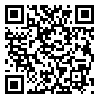Volume 12, Issue 1 (4-2021)
JAP 2021, 12(1): 31-43 |
Back to browse issues page
1- University of Mohaghegh Ardabili , amiralijafarnezhad@gmail.com
2- University of Mohaghegh Ardabili
2- University of Mohaghegh Ardabili
Abstract: (1985 Views)
Aims and background: To have proper balance, proper communication between body systems and environment
is essential. Disruption of these systems causes problems for the individual, which can be seen in diabetic patients
with osteoarthritis. Therefore, the aim of this study was to investigate the effect of 8 sessions of balance exercises
and traction loops on the joint position sense of the knee and ankle in Diabetic patients had osteoarthritis of the
knee.
Materials & Methods: This study was performed on elderly diabetic patients with osteoarthritis. Subjects were
divided into control and intervention groups and actively and passively reconstructed joint angles and balance
time was recorded on both legs. The training phase was balanced. In the test phase, the amount of joint error and
balance time on one leg were recorded twice. Correlated t-test was used to compare variables between different
pre-training and post-training conditions. The significance level for all analyzes was 0.05.
Results: The results showed that 45 ° flexion movements of the left knee (P = 0.001), 20 ° flexion of the right knee
(P = 0.038), 20 ° flexion of the left knee (P = 0.001), dorsiflexion of the right ankle (P = 0.016) and plantar flexion
of the left ankle (P = 0.001) was significantly reduced compared to the pre-exercise stage in the intervention
group. Also, no significant difference was observed in the control group.
Conclusion: The results of this study showed that trapezoidal loops exercises have improved the reconstruction
of joint angles and balance time in diabetic patients with osteoarthritis. Therefore, it is recommended that this type
of exercise be included in the exercise program of diabetic patients with elderly osteoarthritis.
is essential. Disruption of these systems causes problems for the individual, which can be seen in diabetic patients
with osteoarthritis. Therefore, the aim of this study was to investigate the effect of 8 sessions of balance exercises
and traction loops on the joint position sense of the knee and ankle in Diabetic patients had osteoarthritis of the
knee.
Materials & Methods: This study was performed on elderly diabetic patients with osteoarthritis. Subjects were
divided into control and intervention groups and actively and passively reconstructed joint angles and balance
time was recorded on both legs. The training phase was balanced. In the test phase, the amount of joint error and
balance time on one leg were recorded twice. Correlated t-test was used to compare variables between different
pre-training and post-training conditions. The significance level for all analyzes was 0.05.
Results: The results showed that 45 ° flexion movements of the left knee (P = 0.001), 20 ° flexion of the right knee
(P = 0.038), 20 ° flexion of the left knee (P = 0.001), dorsiflexion of the right ankle (P = 0.016) and plantar flexion
of the left ankle (P = 0.001) was significantly reduced compared to the pre-exercise stage in the intervention
group. Also, no significant difference was observed in the control group.
Conclusion: The results of this study showed that trapezoidal loops exercises have improved the reconstruction
of joint angles and balance time in diabetic patients with osteoarthritis. Therefore, it is recommended that this type
of exercise be included in the exercise program of diabetic patients with elderly osteoarthritis.
Type of Study: Original |
Subject:
Acute pain managment
Received: 2020.10.28 | Accepted: 2020.11.16 | Published: 2021.04.30
Received: 2020.10.28 | Accepted: 2020.11.16 | Published: 2021.04.30
| Rights and permissions | |
 |
This work is licensed under a Creative Commons Attribution-NonCommercial 4.0 International License. |



